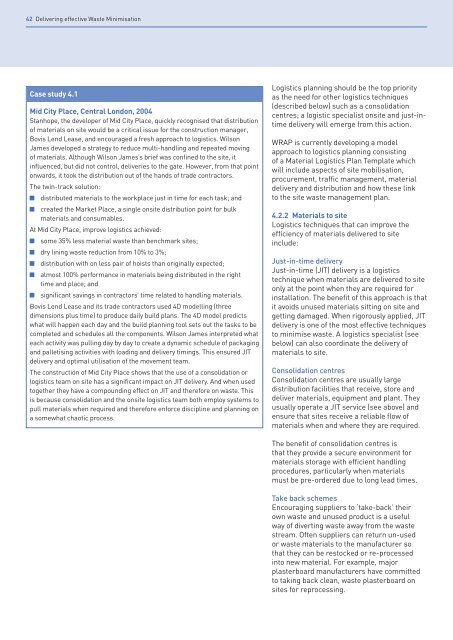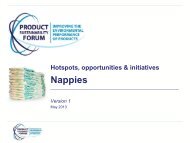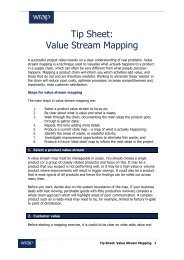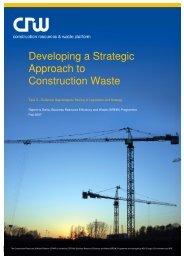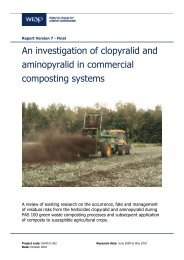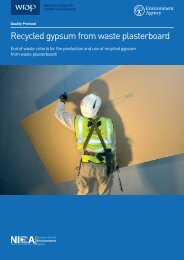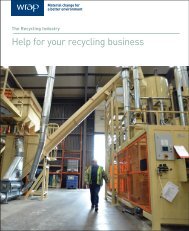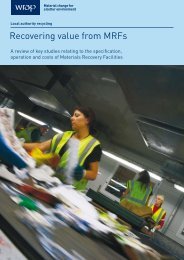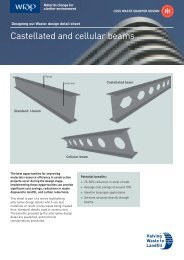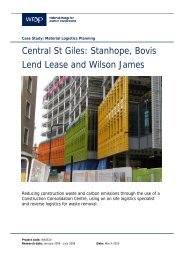Delivering effective Waste Minimisation - Wrap
Delivering effective Waste Minimisation - Wrap
Delivering effective Waste Minimisation - Wrap
Create successful ePaper yourself
Turn your PDF publications into a flip-book with our unique Google optimized e-Paper software.
42 <strong>Delivering</strong> <strong>effective</strong> <strong>Waste</strong> <strong>Minimisation</strong><br />
Case study 4.1<br />
Mid City Place, Central London, 2004<br />
Stanhope, the developer of Mid City Place, quickly recognised that distribution<br />
of materials on site would be a critical issue for the construction manager,<br />
Bovis Lend Lease, and encouraged a fresh approach to logistics. Wilson<br />
James developed a strategy to reduce multi-handling and repeated moving<br />
of materials. Although Wilson James’s brief was confined to the site, it<br />
influenced, but did not control, deliveries to the gate. However, from that point<br />
onwards, it took the distribution out of the hands of trade contractors.<br />
The twin-track solution:<br />
distributed materials to the workplace just in time for each task; and<br />
created the Market Place, a single onsite distribution point for bulk<br />
materials and consumables.<br />
At Mid City Place, improve logistics achieved:<br />
some 35% less material waste than benchmark sites;<br />
dry lining waste reduction from 10% to 3%;<br />
distribution with on less pair of hoists than originally expected;<br />
almost 100% performance in materials being distributed in the right<br />
time and place; and<br />
significant savings in contractors’ time related to handling materials.<br />
Bovis Lend Lease and its trade contractors used 4D modelling (three<br />
dimensions plus time) to produce daily build plans. The 4D model predicts<br />
what will happen each day and the build planning tool sets out the tasks to be<br />
completed and schedules all the components. Wilson James interpreted what<br />
each activity was pulling day by day to create a dynamic schedule of packaging<br />
and palletising activities with loading and delivery timings. This ensured JIT<br />
delivery and optimal utilisation of the movement team.<br />
The construction of Mid City Place shows that the use of a consolidation or<br />
logistics team on site has a significant impact on JIT delivery. And when used<br />
together they have a compounding effect on JIT and therefore on waste. This<br />
is because consolidation and the onsite logistics team both employ systems to<br />
pull materials when required and therefore enforce discipline and planning on<br />
a somewhat chaotic process.<br />
Logistics planning should be the top priority<br />
as the need for other logistics techniques<br />
(described below) such as a consolidation<br />
centres; a logistic specialist onsite and just-intime<br />
delivery will emerge from this action.<br />
WRAP is currently developing a model<br />
approach to logistics planning consisting<br />
of a Material Logistics Plan Template which<br />
will include aspects of site mobilisation,<br />
procurement, traffic management, material<br />
delivery and distribution and how these link<br />
to the site waste management plan.<br />
4.2.2 Materials to site<br />
Logistics techniques that can improve the<br />
efficiency of materials delivered to site<br />
include:<br />
Just-in-time delivery<br />
Just-in-time (JIT) delivery is a logistics<br />
technique when materials are delivered to site<br />
only at the point when they are required for<br />
installation. The benefit of this approach is that<br />
it avoids unused materials sitting on site and<br />
getting damaged. When rigorously applied, JIT<br />
delivery is one of the most <strong>effective</strong> techniques<br />
to minimise waste. A logistics specialist (see<br />
below) can also coordinate the delivery of<br />
materials to site.<br />
Consolidation centres<br />
Consolidation centres are usually large<br />
distribution facilities that receive, store and<br />
deliver materials, equipment and plant. They<br />
usually operate a JIT service (see above) and<br />
ensure that sites receive a reliable flow of<br />
materials when and where they are required.<br />
The benefit of consolidation centres is<br />
that they provide a secure environment for<br />
materials storage with efficient handling<br />
procedures, particularly when materials<br />
must be pre-ordered due to long lead times.<br />
Take back schemes<br />
Encouraging suppliers to ‘take-back’ their<br />
own waste and unused product is a useful<br />
way of diverting waste away from the waste<br />
stream. Often suppliers can return un-used<br />
or waste materials to the manufacturer so<br />
that they can be restocked or re-processed<br />
into new material. For example, major<br />
plasterboard manufacturers have committed<br />
to taking back clean, waste plasterboard on<br />
sites for reprocessing.


